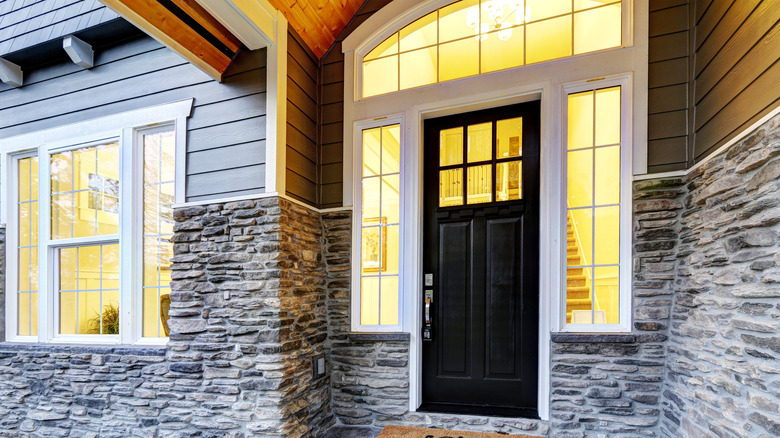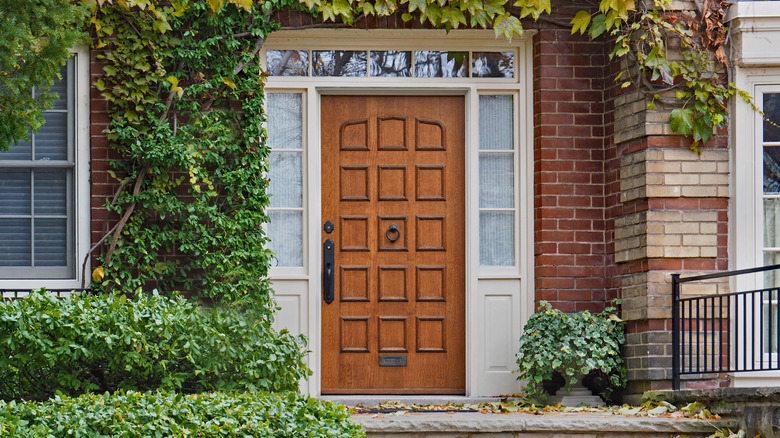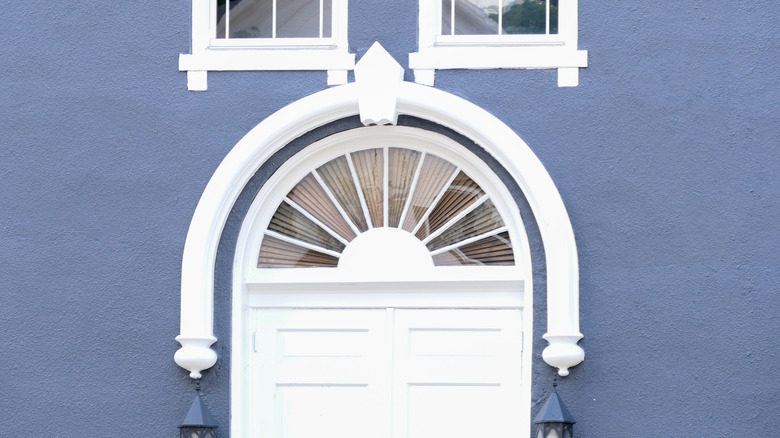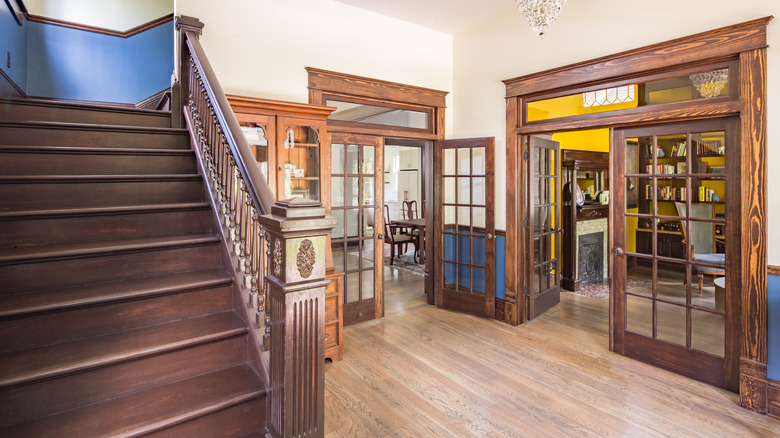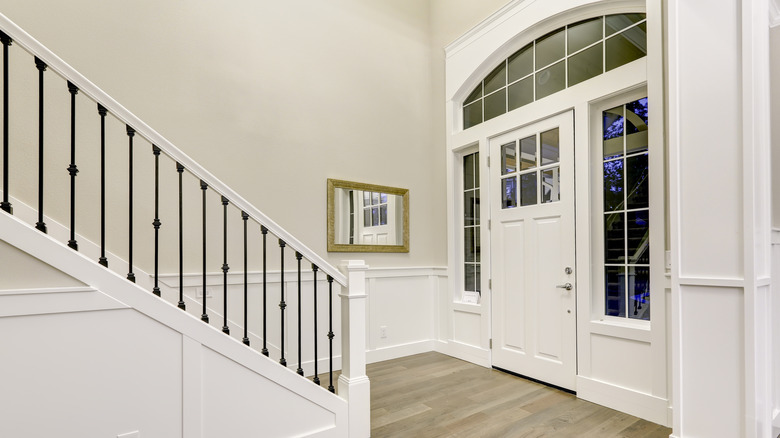Transom Windows: What To Know Before You Buy
A front door says a lot about a house. A bold pop of color on your door against a neutral shade of siding? We're willing to bet that you're in on the latest trends and love to liven up your space, but you don't want to dip your toes too far into any old fad, either. Or maybe you have a sleek, all-black solid door, inviting any guests into your (evidently) chic and classic home. Regardless of your color choice or style preference, there's one option that many homeowners are turning to for some added natural light in their entryways, and that's transom windows.
These beautiful border windows come in a variety of styles and shapes that can complement any front porch, but with so many options comes a bit of inevitable research. We're here to clue you in on all you need to know about this timeless feature piece so that you're prepared to pick the best transom window for your space — and your budget.
What are transom windows?
You may not have known them by name, but chances are, you've walked through a door with a transom window time and time again. Glass.com explains that they're the small windows directly above a door's transom, or the top beam of a passageway. They're usually of equal width, and are intended to bring in some additional light by transferring it from surrounding areas. Transom windows also function as decorative pieces, both on the exterior and interior of a home. With the many styles, materials, and shapes offered to choose from, these windows add a timeless bit of character and charm to any doorway.
Despite popping up in recent builds all over, transom windows are nothing new — these windows first hit the home scene centuries ago, but purely for functionality purposes. Back before the glorious invention of air condition, transom windows were always operational and opened up separately from the door below, according to Glass.com. This allowed for better air ventilation throughout the home. Nowadays, transom windows are more commonly installed as fixed features, which means they don't fully open up, but light can still shine through from outside to inside, or from room to room. Functional transom windows are less of a necessity and therefore aren't as popular, but if you want a bit of a breeze through your home, you can opt for one for a premium price.
Types of transom windows
Transom windows can be ordered as functional or non-functional, with trim to match the existing doorframe (like wood, metal, or vinyl). Since they're often used as decorative accents or architectural features, it's common to find transom windows with unique characteristics like etched or stained glass panels as well, says Window Guide.
United Home Experts breaks down the main categories of shapes for transom windows into three varieties: paneled, solid, and fanned. Paneled and solid transom windows are typically rectangular in shape and match the width of the door to create a symmetrical appearance. Paneled transom windows feature pieces of vertical or horizontal matching trim that break up the glass, while more intricate styles are solid.
Fanned transom windows, also known as fanlights or Federal-style transoms, are semicircular to create an archway effect at the top of a doorway, explains Window Guide. Any of the shapes or sizes can come as operable or inoperable, but most indoor styles are not functional. Operable transom windows can be either automated or closed manually with a window pole (or a ladder, if you're committed). If you do incorporate a functional transom window, be sure to consider elements like whether it's on the interior or exterior of your home — if it's on the outside, you need to account for weather, bugs, and safety mechanisms or locks when choosing your window.
Where to place transom windows
Transom windows are most commonly found on an exterior doorway, thanks to the architectural element it adds to your house's curb appeal. They're also a great option to enhance your front door, add light without any bulbs or fixtures, and make your entryway more of a statement. Although they're popular for outdoor use, Modernize recommends bringing them into the interior of your home as well!
When placed in interior doorways, transom windows allow natural light to pass through from space to space, says Modernize. You should add them in rooms that have no exterior windows — this will let some of the sunlight from surrounding rooms brighten up the space, which will in turn make the closed off room feel bigger, fresher, and more inviting for yourself and your guests.
The only caveat? Transom lights require high ceilings, since you'll need a decent chunk of height above the doorway to accommodate the feature. You may need to search for a custom or special-ordered narrow version if you have ceilings around the standard eight foot height, or transom windows may not be an option at all. Another point to consider is if your interior wall is load-bearing — if so, it may be difficult to remove drywall and adjust the wall studs as needed to install the transom window, so reach out to a contractor for assistance with the project (via Bob Vila).
Average cost of transom windows
If you're already installing a new door, a transom window isn't much to add on, depending on where it's placed. According to Window Guide, many exterior doors already come with a transom window included, since they're so popular. Just expect to pay a few thousand for the entire set — that'll include the necessary weatherproofing, as well as the door, doorframe, cladding, sidelights, and the transom window to match. If you're buying the window separately, expect the price to vary slightly depending on the style and functionality you're looking for. Functional transom windows that open or close will cost you more, but you get the added benefit of ventilation. A non-operable, fixed transom window will cost a bit less, but the price may fluctuate if you spring for a higher-end material, a decorative glass feature, or premium wood finish.
Window Guide says that the average price for a standard-sized, lower-end vinyl or wood transom window is about $100. As the quality of the material increases, so does the price — you may even spend upwards of $240 on the piece alone. Installation is another $75-$200 on average, but if you have the wiggle room in your window budget, it's an investment worth considering!
